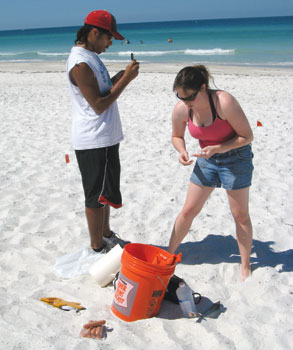Study of fire ants may help turtles

SUN PHOTO/LAURIE KROSNEY USF graduate student
Jaeson Clayborn, left, is doing his master’s
degree work on fire ant behavior. Here,
Clayborn and his assistant, recent Eckerd
College graduate Zoey Pratt, prepare test
tubes that are loaded with bits of hot dog as
bait to be laid in vectors going from the
vegetation line to the rack line in Holmes Beach.
HOLMES BEACH — Fire ants can be problematic for turtles, as well as every other creature. The insects, which are native to South America, have few predators in Florida and other parts of the South.
"They pretty much take over everything," said Jaeson Clayborn, who is working in cooperation with Anna Maria Island Turtle Watch to study ant behavior on this Island and on beaches to the north and south. "They predate turtle nests and can be quite troublesome."
"Fire ants are a big problem,’ AMITW Director Suzi Fox agreed. "They can wipe out a whole nest almost overnight."
The fire ants are prone to locating their nests near trashcans placed at beach accesses where there’s a reliable source of food, according to Clayborn.
"They make foraging tunnels under the sand in all directions," he said. "Scouts travel those tunnels looking for food, and when they find a turtle nest, they signal the other ants that there’s a good food source."
The ants can’t break through the rubbery shell of the turtle eggs, but when a raccoon predates (vandlaizes) a nest, or a crack develops in an egg, they all rush to the nest and consume everything.
"You can use Amdro or another product like that,’ Clayborn said. "But that just works for single-queen colonies. More and more colonies are multi-queen colonies, and it’s difficult to kill all the queens."
Clayborn said that the ants forage from their colony near or in the vegetation by the dunes by way of tunnels beneath the sand and by the rack line, where high tides leave bits of shell and vegetation.
"The sand in the mid zone is just too hot for them during most of the day," he said. "Even in the evening, the heat from the day has warmed the sand well underground."
When the beach is wide enough, it’s Clayborn’s hypothesis that turtle nests in the mid-beach zone between the dunes and the rack line, are much safer from fire ants.
"They don’t smell or sense the eggs in that area," he said. "In other areas, the scouts pop their heads up out of their tunnels to look around from time to time.
"But in the middle of the beach, it’s too hot in the day, and unless their foraging tunnels go right through a nest, they won’t know the eggs are there."
In Clayborn’s research project, he is placing test tubes baited with a bit of hot dog in vectors from up in the dunes to the rack line. (A vector is an imaginary line from place to place.)
If his hypothesis is correct, then the bait traps placed in the middle of the beach will have fewer ants in them. He checks each test tube after 30 minutes and again after an hour.
Clayborn is fascinated by the behavior of fire ants. He’s working on his master’s degree under Deby Cassill, who is a well-known scientist in the field.
He said that there are experiments to import a type of fly that is one of the few predators of fire ants.
"The flies pierce the ant’s body, lay their eggs, and when the eggs hatch, the ant is killed," he said. "In South America, fire ants aren’t nearly the problem they are here, because their predators keep them in balance."
And by the way, Clayborn has no reaction when he gets a fire ant bite.



